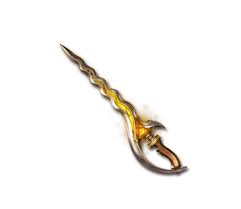Key Point: The Taming Sari is a traditional Malay dagger known for its distinct wavy blade and hilt design. With an overall length ranging from approximately 30 to 40 centimeters, this dagger holds a significant place in Malay folklore.
Today we are taking a look at what Taming Sari is and what powers it was said it had. A mythical weapon from the Malay folklore. So, if you are a fan of mythological weapons you are in for a treat.
So, let’s take a look at the legend of taming sari … Starting with, what is taming sari?
Definition Of Taming Sari

Taming Sari is a legendary Malay weapon with a curved blade. It is said it was given to the warrior Hang Tuah by the Sultan of Malacca. The blade was said to have been made by a legendary blacksmith and was believed to possess supernatural powers, (like control over the weather) making it almost invincible in battle.
Let’s check out what kind of powers are attributed to the blade.
Abilities Of Taming Sari
According to legend …
Taming Sari was able to inflict wounds that could not be healed by normal means. It was also said that the weapon would only allow its owner to draw blood from an enemy. Meaning if anyone else tried to wield it, the blade would refuse to cut. These mythical properties of Taming Sari made it a highly sought-after weapon among warriors and kings.
And if you want to talk about a really overpowered weapon.
In addition to its healing properties, Taming Sari was also said to possess the power to control the elements. It was said that the weapon could summon storms, cause earthquakes, and control the tides. According to folklore, Hang Tuah used the weapon to calm the raging seas during a storm. Which earned him the respect of his fellow warriors. In my opinion, they were just terrified.
So, where do these powers come from?
Origin Of Taming Sari Abilities
The mystical powers of Taming Sari were said to be derived from the supernatural entities that were infused within the weapon. According to legend, the blade was said to have been imbued with the power of a mystical serpent, which gave it its invincibility in battle. It was also believed that Taming Sari could heal its wielder of any injuries, but only if the wound was inflicted by the same blade.
Before we move on to the next point, it’s worth mentioning that Taming Sari is an important part of Malay folklore and has been featured in many stories and legends.
Let’s check out a few right now …
Stories About Taming Sari
One of the most famous stories involves the warrior Hang Tuah, who was said to have used Taming Sari to defeat a powerful enemy in single combat. The enemy, who was also a skilled warrior, was said to have been struck down by the blade of Taming Sari, despite his own legendary skills in battle.
Another story features a young prince who was given Taming Sari by his father, the king, in order to defend himself against an invading army. The prince was said to have used the weapon effectively, inflicting heavy losses on the enemy forces and turning the tide of the battle.
To tie everything together, let’s explore how Taming Sari has been presented in modern media.
Modern Depictions
Taming Sari has been featured in various forms of media, including movies, television shows, and video games. One notable example is the 1952 film “Hang Tuah”, which tells the story of the legendary warrior and his adventures with Taming Sari.
The weapon has also appeared in several video games, including the popular game “Final Fantasy XV”, where it appears as a powerful and rare weapon that can be obtained by the player.
Taming Sari has also been celebrated in traditional Malay arts, such as dance and music. Many traditional Malay dances feature performers wielding the weapon, and it is often portrayed as a symbol of martial prowess and courage.
In Conclusion
Thank you for taking the time to read this article. I hope you learned something new about this weapon from the Malay legend. And I hope to see you at the next one.
Take care!
Sources:
“The Malay Art of Self-Defense” by Sheikh Shamsuddin
“Tales of Malay Folklore” by Usman Awang